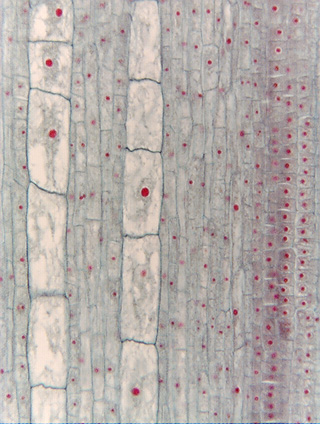 Fig.
7.5-1. Longitudinal
section of root of cattail (Typha). The large white cells in the two
prominent rows are precursors to vessel elements.
Whereas surrounding cells are still dividing as they grow, these precursors are
enlarging without dividing. As they are growing, they have only a primary wall,
not a secondary one, so they are parenchyma cells at this stage. Once they
achieve the proper size, they will stop expanding and begin depositing the
secondary wall. Because these will become vessels not tracheids, the
cross walls can be called perforation partitions: their margins might
become covered with lignified secondary wall (then it will be the perforation
plate rim) but the center will be digested away and become the perforation, the
actual hole in the wall.
Fig.
7.5-1. Longitudinal
section of root of cattail (Typha). The large white cells in the two
prominent rows are precursors to vessel elements.
Whereas surrounding cells are still dividing as they grow, these precursors are
enlarging without dividing. As they are growing, they have only a primary wall,
not a secondary one, so they are parenchyma cells at this stage. Once they
achieve the proper size, they will stop expanding and begin depositing the
secondary wall. Because these will become vessels not tracheids, the
cross walls can be called perforation partitions: their margins might
become covered with lignified secondary wall (then it will be the perforation
plate rim) but the center will be digested away and become the perforation, the
actual hole in the wall.